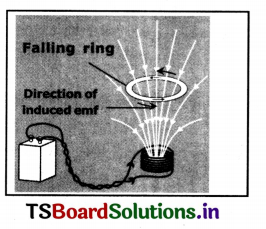Telangana SCERT 10th Class Physics Study Material Telangana 10th Lesson Electromagnetism Textbook Questions and Answers.
TS 10th Class Physical Science Solutions 10th Lesson Electromagnetism
Improve Your Learning
I. Reflections on concepts
Question 1.
Are the magnetic field lines closed? Explain.
Answer:
1. The field lines appear to be closed loops but you can’t conclude that lines are closed or open loops by looking at the picture of field lines because we do not know about alignment of lines that are passing through the bar magnet.
2. The direction of a magnetic line at any point gives the direction of the magnetic force on a north pole placed at that point.
3. Since the direction of magnetic field line is the direction of force on a north pole, the magnetic lines always begin from the ‘N’ pole of the magnet and end on the ‘S’ pole of the magnet.
4. Inside the magnet however the direction of magnetic lines is from S-pole of the magnet to the N-pole of the magnet.
5. Thus the magnetic field lines are closed.
Question 2.
See figure, magnetIc lines are shown. What is the direction of the current flowing through the wire?
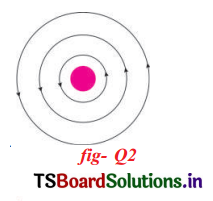
Answer:
1) The magnetic field lines are in the anti-clockwise direction.
2) The direction of current is vertically upwards. This can be demonstrated with right-hand thumb rule.
Question 3.
A bar magnet with North pole facing towards a coil moves as shown In figure given below. What happens to the magnetic flux passing through the coil?
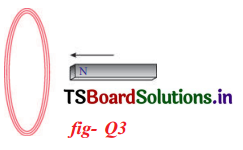
Answer:
The magnetic flux passing through the coil induces current in the coil. This current is called induced EMF. This induced N EMF is equal to the rate of change of magnetic flux passing through it.
![]()
Question 4.
A coil is kept perpendicular to the page. At P, current flows into the page and at Q it comes out of the shown in figure. What is the page as direction of magnetic field due to the coil?
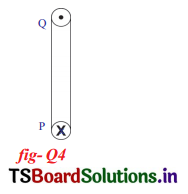
Answer:
To know the direction of magnetic field, we use right-hand rule i. e., ‘when you curl your right-hand fingers ¡n the direction of current, thumb gives the direction of magnetic field’. According to this the direction of magnetic field is as shown in the following figure.
Application of Concepts
Question 1.
The direction of current flowing in a coil Is shown in figure. What type of magnetic pole Is formed at the face that has flow of current as shown in fig.
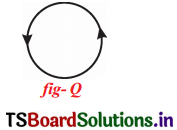
Answer:
The top surface of the coil shown in the fig. behaves as North pole and direction of magnetic field points towards us.
Question 2.
Why does the picture appear distorted when a bar magnet is brought close to the screen of a television? Explain.
Answer:
Picture on a television screen Is due to motion of the electrons reaching the screen. These electrons are affected by magnetic field of bar magnet. This is due to the fact that the magnetic field exerts a force on the moving charges. This force is called magnetic force. Due to this magnetic force, the picture is distorted when you remove the bar magnet away from the screen, the motion of electron is not affected by the magnetic force and the picture will be normal.
Question 3.
Symbol ‘X’ indicates the direction of a magnetic field into the page. A straight long wire carrying current along its length is kept perpendicular to the magnetic field. What A is the magnitude of force experienced by the wire? In what direction does it act?
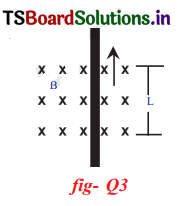
Answer:
From the figure, a straight wire carrying current which Is kept perpendicular to a uniform magnetic field B. This ‘B’ is directed Into the page. Let the field be confined to the length L. We know that the electric current means charges in motion. Hence they move with a certain velocity called drift velocity V.
The magnetic force on a single charge is given by F0 = qv B.
Let total charge inside the magnetic field be Q. So magnetic force on the current carrying wire s given by F=QvB ……………………………. (1)
The time taken by the charge (Q) to cross the field be
t = \(\frac{L}{v} \Rightarrow v=\frac{L}{t} \) ……………………………. (2)
∴ (1) ⇒ F = \(\frac{\mathrm{QLB}}{\mathrm{t}} \Rightarrow \frac{\mathrm{Q}}{\mathrm{t}}(\mathrm{LB}) \) …………………………. (3)
We know that \( \frac{\mathrm{Q}}{\mathrm{t}}\) Is equal to the electhc current in the wire.
I = \(\frac{Q}{t} \)
∴ (3) ⇒ FILB.
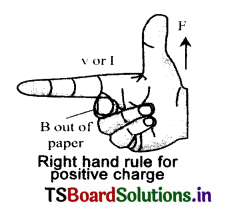
The direction of the force: The direction of force can be find by using right-hand rule. Fore finger points towards the velocity of current, middle finger points to the direction of magnetic field (B), then the thumb gives direction of force when the three fingers are stretched in such away that they are perpendicular to each other.
![]()
Question 4.
An 8N force acts on a rectangular conductor 20 cm long placed perpendicular to a magnetic field. Determine the magnetic field induction if the current in the conductor is 40 A.
Answer:
Formula, F = ILB (or) B = F/IL
Where F = magnetic force = 8N
I = Electrical current in the conductor = 40 A
L, length of conductor = 20 cm. = \(\frac{20}{100}\) = 0.2 mt
∴ B =?
B= \(\frac{8}{40 \times 0.2}=\frac{80}{40 \times 2} \) = 1
Magnetic field induction = 1 tesla.
Question 5.
As shown in figure both coil and bar magnet move in the same direction. Your friend is arguing that there is no change in flux. Do you agree with his statement’ If not what doubts do you have? Frame questions about the doubts you have regarding change in flux.
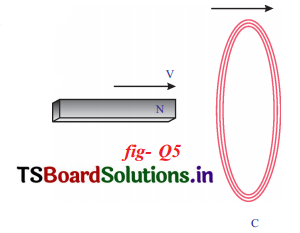
Answer:
Agree: Yes. I will agree.
- The induced EMF will not produce when the coil and magnet are moving in the same direction with same velocity.
- Hence my friend’s argument is correct.
Disagree:
- What happens if both magnet and coil move in same direction?
- What happens if both magnet and coil move in opposite direction?
- What is the direction of the current in the coil?
- If both move in same direction, is there any linkage of flux with the coil?
- When N pole is moved towards the coil what is the direction of current?
- If magnet is reversed, what is the direction of current in the coil?
Question 6.
Give a few applications of Faraday’s law of induction in daily life.
Answer:
The daily life applications of Faraday’s law of induction are :
- Generation of electricity.
- Transmission of electricity.
- Metal detectors in security checking.
- The tape recorder.
- Use of ATM cards
- Induction stoves
- Transformers
- Induction coils (spark plugs in automobiles)
- Break system in railway wheels
- AC and DC generators
- Windmills etc.
Question 7.
Explain the working of an electric motor with a neat diagram.
Answer:
1. Consider a rectangular coil kept in uniform magnetic field as shown in figure.
2. Switch on the circuit so that the current flows through the coil. The direction of current is shown in the figure.
3. The sides AB and CD of the coil are always at rigi angles to the magnetic field.
4. According to right-hand rule, at AB the magnetic force acts inward perpendicular to the field of magnet ai
on CD, it acts outward.
5. The top view of coil is shown in the figure.
6. The force on the sides BC and DA varies because they make different angles at different positions of the coil in the field. At BC, magnetic force pulls the coil up and at DA magnetic force pulls it down.
7. The net force acting on AB and on CD is zero because they carry equal currents in the opposite direction.
Similarly, the sum of the forces on sides BC and DA is also zero. So, net force is zero on the coil.
8. But the rectangular coil comes into rotation in clockwise direction because equal and opposite pair of forces acting on the twos sides of the coil.
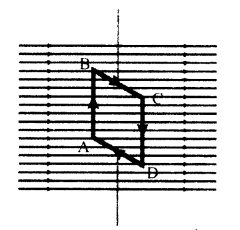
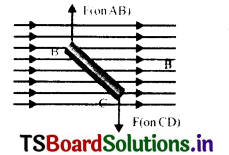
9. If the direction of current in the coil is unchanged, it rotates, upto half rotation In one direction and the next half In the direction opposite to previous like to and fr0 motion.
10. It the direction of current in the coil is changed the coil will rotate continuously in one and the same direction.
11. To achieve this, brushes B, and B2 are used.
12. These brushes are connected to the battery. The ends of the coil are connected to slip rings C1 and C2 which rotate along with the coil.
13. Initially C1 is In contact with B1 and C2 Is in contact with B2
14. After half rotation, the brushes come into contact with the other slip rings in such a way that the direction of current through the coil Is reversed. This happens every half-rotation.
15. Thus the direction of rotation of the coil remains the same. This is the principle used in electric motor.
16. In electric motors electrical energy is converted Into mechanical energy.
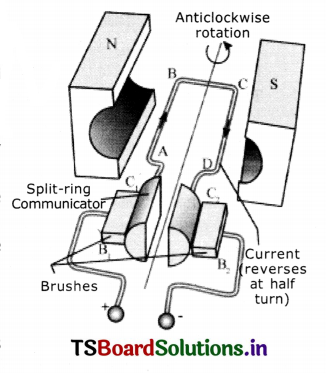
Question 8.
Explain the working of AC electric generator with a neat diagram.
Answer:
(i) Electric Generator or Dynamo: It is a device which converts mechanical energy into electrical energy.
(ii) Principle: It works on the principle of the electromagnetic induction.
(iii) Construction:
It consists of
(i) Armature coil,
(ii) Brushes,
(iii) Slip rings,
(iv) Strong magnet and
(v) Rotating mechanism (or) motor.
The two A and B of the coil ABCD are connected to the slip rings.
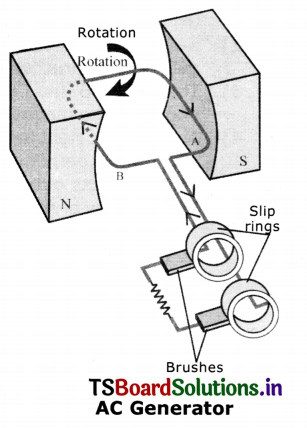
Working:
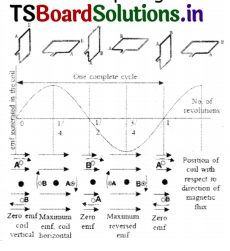
- When the coil is at rest ¡n vertical position, with side (A) of coil at top position and side (B) at bottom position, no current will be induced in it. Thus current in the coil is zero at this position.
- When the coil is rotated in clockwise direction, current will be induced in it and it flows from A to B, in this position the current increases from zero to a maximum.
- If we continue the rotation of coil current decreases during the second quarter of the rotation and once again becomes zero when coil comes to vertical position with side B at top side and side A at bottom position.
- During the second half of the rotation, current generated follows the same patterns as that in the first half, except that the direction of current is reversed.
- Thus, after every rotation of the current ¡n the respective arm changes, there by generating an alternating current. This device is called A.C. generator.
Question 9.
Explain the working of DC generator with a neat diagram.
Answer:
- Consider a rectangular coil. Let it be held between the poles of curve-shaped permanent magnets as shown in figure.
- As the coil rotates the magnetic flux passing through the coil changes.
- According to the law of electromagnetic induction, an induced current is generated in the coil.
- If two half-slip rings are connected to the ends of the coil as shown in figure, this generator works as DC generator to produce DC current.
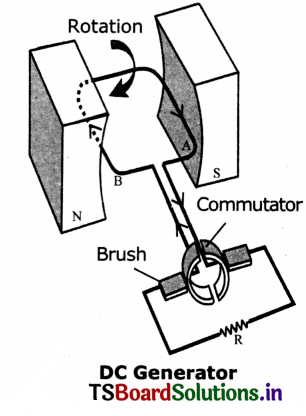
Working:
- When the coil is in vertical position the induced current generated during the first half rotation, rises from zero to maximum and then falls to zero again.
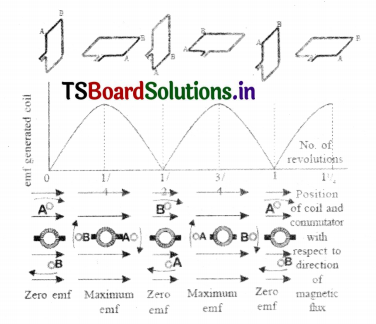
2. As the coil moves further from this position, the ends of the coil go to other slip rings.
3. Hence, during the second half rotation, the current is reversed in the coil itself, the current generated in the second half rotation of the coil is identical with that during the first half of the direct current (DC), for one revolution.
4. Hence, this current ¡s called direct current (DC).
![]()
Question 10.
How do you appreciate Faraday’s law, which s the consequence of conservation of energy?
Answer:
- Faraday’s law of electromagnetic induction, which is the outcome of law of conservation of energy, is very much useful.
- The law led to the conclusion that mechanical energy can be converted into electrical energy.
- The fruits of electrical energy, namely, the electric lights, the stoves, electric heaters, electrical irons, the fridge, the electric motor the television, the electronic locomotives and all electric gadgets are serving mankind and making people more comfortable.
- All these gadgets work on electricity and electrical energy that can be produced by generators on large scale where energy Is created by law of conservation of energy on a very large scale.
- So, we must appreciate the utilïtanan value of Faraday’s law which is the consequence of conservation of energy.
Question 11.
The value of magnetic field Induction which is uniform is 2T. What is the flux passing through a surface of area 1.5m1 perpendicular to the field?
Answer:
Magnetic Induction of uniform field B = 2T
Flux Φ =?
Surface area A = 1.5 m2
We know B = \(\frac{\varphi}{A} \) ⇒ BA cosθ
Φ= BA
Where B ¡s perpendicular to area is
ΔΦ = 2x 1.5=3webers
Question 12.
Which of the various methods of current generation protects nature well? Give examples to support your answer. )
Answer:
The methods of current generation that protect the nature well:
1. Hydra power plant A power plant that produces electricity by using flowing of water to rotate a turbine Is called hydropower plant.
Advantages:
- It does not produce any environmental pollution.
- It will never get exhausted.
- The construction of dams on rivers helps In controlling floods and in irrigation.
2. Wind generators: A wind generator s used to generate electricity by using wind energy.
Advantages:
- It does not cause any pollution.
- It will never get exhausted.
- Wind energy is available free of cost.
3. Solar cell: Solar cell is a device which converts solar energy directly into electricity.
Advantages:
- They require no maintenance.
- They can be set up in remote inaccessible and very sparsely inhabited areas where the laying of usual power transmission is different and expensive.
- As seawater flows in and out of the tidal barrage during high and low tides It turns the turbines to generate electricity.
- The energy of moving sea waves can be used to generate electricity.
- The energy available due to the difference In the temperature of water at the surface of the ocean and at deeper levels is called ocean thermal energy. The ocean thermal energy can be converted into a usable form of energy like electricity.
- Geothermal energy is the heat energy from hot rocks present inside the earth. It is also used to produce electricity. It is a clean and environmental friendly source of energy.
- The energy produced during nuclear fission reactions is used for generating electricity at nuclear power plants.
Multiple choice questions
Question 1.
Which of the following converts electrical energy into mechanical energy [ ]
(a) motor
(b) battery
(c) generator
(d) switch
Answer:
(a) motor
Question 2.
Which of the following converts mechanical energy into electrical energy [ ]
(a) motor
(b) battery
(c) generator
(d) switch
Answer:
(c) generator
Question 3.
The magnetic force on a current-carrying wire placed in uniform magnetic field if the wire is oriented perpendicular to magnetic field is [ ]
(a) 0
(b) ILB
(c) 2ILB
(d) \(\frac{\text { ILB }}{2} \)
Answer:
(b) ILB
Question 4.
One Tesla = [ ]
(a) Newion/Coloumb
(b) Newton / ampere – meter
(c) Ampere I meter
(d) Newton / ampere second
Answer:
(b) Newton/ampere – meter
Question 5.
Magnetic flux [ ]
(a) dyne
(b) Oersted
(c) Guass
(d) Weber
Answer:
(d) Weber
Question 6.
No force works on the conductor carrying electric current when kept [ ]
(a) parallel to magnetic field
(b) perpendicular to magnetic field
(c) in the magnetic field
(d) away from magnetic field
Answer:
(a) parallel to magnetic field
Suggested Experiments
Question 1.
Explain with the help of two activities that current-carrying wire produces magnetic field.
Answer:
Activity – 1.
- Take a wooden plank and make a hole as shown in adjacent figure. Table
- Place the plank on the table.
- Place a retort stand on the plank as shown in figure.
- Pass 24 gauge copper wire through a hole of the plank and rubber knob of the retort stand In such a way that the wire be arranged In a vertical position and not touch the stand.
- Connect the two ends of the wire to a battery via switch.
- Place 6 to lo compass needles In a circular path around the hole so that its centre coincides with the hole. Use 3-volt battery In the circuit.
- Switch on current.
- We see the compass needles change the direction In such a way as tangents to the circle.
- This activity helps us to prove current carrying wire produces magnetic field.
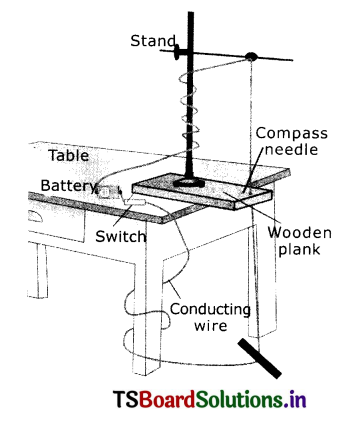
Activity -2
1. Take a thin wooden plank covered with white paper.
2. Make equidistant holes on its surface as shown in adjacent figure.
3. Pass copper wire through the holes. This forms a coil. Join the ends of the coil to a battery through a switch.
4. Switch on the circuit. Current passes through the coil.
5. Now sprinkle iron filings on the surface of the plank around the coil.
6. Give small jerk to It. An orderly pattern of iron filing is seen on the paper.
7. This activity proves that a current-carrying wire develops a magnetic field around it.
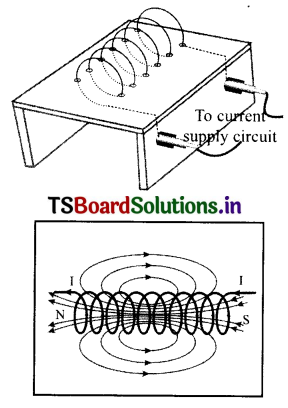
Question 2.
How do you verify experimentally that the current-carrying conductor experiences a force when it is kept in a magnetic field?
(Or)
List out the apparatus and experimental procedure for the experiment to observe a current-carrying wire experiences a magnetic force when it is kept in uniform magnetic field.
Answer:
Required apparatus:
- Horse-shoe magnet
- conducting wire
- battery, switch
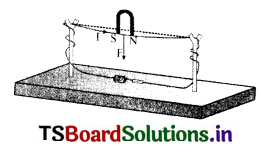
- Take a wooden plank.
- Fix two long wooden sticks on it.
- These wooden sticks are split at their top ends.
- A copper wire is passed through splêts of wooden sticks.
- Connect the wire to 3 volts battery.
- Close the switch to make the circuit. Current passes through the wire.
- Bring a horseshoe magnet near the wire.
- Then a force is experienced on the wire, following right thumb rule.
- Reverse the polarities of the magnet, then the direction of the force is also reversed.
- The night hand rule helps the direction of magnetic force exerted by the magnetic field on the current carring wire.
Question 3.
Explain Faraday’s law of induction with the help of activity.
Answer:
- Connect the terminals of a coil to a sensitive ammeter or galvanometer as shown in the adjacent figure.
- Now push a bar magnet towards the coil, with its north pole facing the coil.
- While the magnet is moving towards the coil the needle in galvanometer deflects, showing that a current has been set up in the coil.
- The needle of galvanometer does not deflect If the magnet is at rest.
- If the magnet Is moved away from the coil, the needle In the galvanometer again deflects, but ¡n the opposite direction.
- It means that a current is set up in the coil in the opposite direction.
- If we use the end of south pole of a magnet instead of north pole in this activity, the experiment works just as described but the reactions are exactly in opposite directions.
- Further experimentation enables us to understand that the relative motion of the magnet and coil sets up a current in the coil. It makes no difference whether the magnet is moved towards the coil or the coil towards, the magnet.
- This proves the Faraday’s law: “Whenever there is a continuous change of magnetic flux linked with a closed coil, a current is generated In the coil.
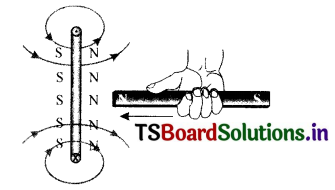
Question 4.
What experiment do you suggest to understand Faraday’s law? What Instruments are required? What suggestions do you give to get good results of the experiment? Give precautions also.
Answer:
Aim: To understand Faraday’s law of induction. Materials required: A coil of copper wire, a bar magnet Galvanometer etc.
Procedure:
- Connect the terminals of a coil to a sensitive galvanometer as shown In the figure.
- Normally we would not expect any deflections of needle in the galvanometer because there is to be no electromotive force In this circuit.
- Now if we push a bar magnet towards the coil, with its north pole facing the coil, we observe the needle in the galvanometer deflects, showing that a current Is set up in the coil.
- The galvanometer does not deflect if the magnet Is at rest.
- If the magnet is moved away from the coil, the needle in the galvanometer again deflects, but in the opposite direction, which means that a current is set up in the coil, in the opposite direction.
- If we use end of south pole of a magnet instead of north pole In the above activity, the deflections are exactly reversed.
- This experiment proves “whenever there is a continuous change of magnetic flux linked with a closed coil, a current Is generated in the coil.
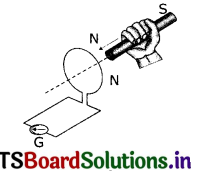
Precautions:
- The coil should be kept on an insulating surface.
- Bar magnet should be of good pole strengths.
- The centre of the Galvanometer scale must be zero.
- The deflections in the galvanometer must be observed while Introducing the bar magnet Into the coil and also while withdrawing It.
![]()
Question 5.
How can you verify that a current-carrying wire produces a magnetic field with the help of an experiment?
Answer:
Aim: To demonstrate that a magnetic field is produced around a current-carrying wire.
Apparatus: Copper wire, slits, 3volt battery, key, and connecting wires, thermocol sheets.
Procedure:
- Take a hermocoI sheet and fix two wooden slits of 1 cm at the top of their ends.
- Arrange a copper wire which passes through slits and make a circuit with the elements as shown in the figure.
- Now, keep a magnetic compass below the wire.
- Bring a barmagnet dose to the compass.
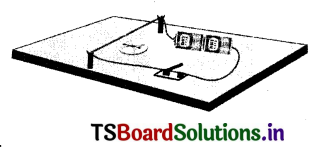
Suggested Projects
Question 1.
Collect Information about generation of current by using Faraday’s law.
Answer:
Faraday’s law is useful In generation of current.
- According to this law, the change in magnetic flux Induces EMF in the coil.
- He also proposed electromagnetic induction.
- Electromagnetic induction is a base for generator, which produces electric Current.
- Transformer also works on the principle of electromagnetic induction, which is helpful In transmission of electricity.
- Hence Faraday’s law is used in the generation and transmission of current.
Question 2.
Collect information about material required and procedure of making a simple electric motor from Internet and make a simple motor on your Own.
Answer:
Material required:
- A plastic pipe of 3 or 4 cm. diameter and 5 cm long.
- A copper wire 30 cm long.
- A horseshoe magnet.
- Two corks that exactly fit Into the bore of the plastic pipe.
- A wooden plank used as base for the whole arrangement.
- Cello tape and small nails.
Procedure:
- Wind the copper wire around the plastic pipe.
- Connect the ends of the wire to the two brushes.
- Fit in the corks into the hollow of the pipe such that they close either end of the pipe.
- By means of vertical pieces of wood and the nails arrange the plastic pipe such that it can rotate freely on the pieces of wood. This acts as the armature.
- Arrange the horseshoe magnet on the wooden base such that the armature lies between both of its poles.
- Now connect the ends of the copper wire to a sensitive galvanometer.
- Rotate the armature freely.
- You can observe reflection in the galvanometer.
- Thus it is an Improvised electric motor.
Question 3.
Collect information of experiments done by Faraday.
Answer:
Experiment – 1
- Connect the terminals of a coil to a sensitive galvanometer as shown n the figure.
- Normally, we would not expect any deflection of needle In the galvanometer because there Is no EMF In the N – circuIt.
- Now, If we push a bar magnet towards the coil, with N Its north pole facing the coil, the needle In the galvanometer deflects, showing that a current has been set up in the coil, the galvanometer does not deflect if the magnet is at rest.
- If the magnet is moved away from the coil, the needle in the galvanometer again deflects, but in the opposite direction, which means that a current is set up in the coil in the opposite direction,
- If we use the end of south pole of a magnet Instead of north pole, the results i.e., the deflections in galvanometer are exactly opposite to the previous one.
- This activity proves that the change in magnetic flux linked with a closed coil, produces current.
- From this Faradays law of induction can be stated as ‘whenever there is a continuous change of magnetic flux linked with a closed coil, a current is generated in the coil” This induced EMF is equal to the rate of change of magnetic flux passing through it.
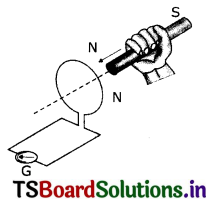
Experiment – 2
1. Prepare a coil of copper wire C1 and connect the two ends of the coil to a galvanometer.
2. Prepare another coil of copper wire C2 similar to C1 and connect the two ends of the coil to a battery via switch.
3. Now arrange the two coils C1 and C2 nearby as shown in the figure.
4. Now switch on the coil C2 We observe a deflection In the galvanometer connected to the coil C1.
5. The steady current in C2 produces steady magnetic field. If coil C2 is moved towards the coil C1, galvanometer shows a deflection.
6. This indicates that electric current Is induced in coil C1.
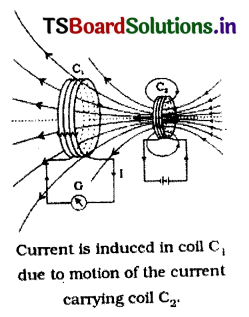
7. When C2 is moved away, the galvanometer shows a deflection again, but this time in the opposite direction.
8. The deflection lasts as long as coil C2 in motion.
9. When C2 is fixed and C1 is moved, the same effects are observed.
10. This shows the induced EMF due to relative motion between two coils.
TS 10th Class Physical Science Electromagnetism Intext Questions
Page 209
Question 1.
How do they (most of the appliances) work?
Answer:
The electronic motor, generators, electric cranes, rice cookers, electrical irons, washing machines, grinders, fans, and many more appliances work on electricity.
Question 2.
How do electromagnets work?
Answer:
By passing D.C. current through a conductor wound around a core, a magnetic field Is developed around the current-carrying conductor and work as a magnet.
Question 3.
Is there any relation between electricity and magnetism?
Answer:
Yes. A current-carrying conductor develops a magnetic field around it.
Question 4.
Can we produce magnetism from electricity?
Answer:
Yes. By passing electric current (D.C) through an insulated wire wound around an iron rod we can produce magnetism by electricity.
Page 210
Question 5.
Does the needle get deflected by the bar magnet?
Answer:
Yes, the needle gets deflected.
Question 6.
why does the needle get deflected by the magnet?
Answer:
When the N-pole of compass needle and N-pole of magnet come close to each other the needle gets deflected due to repulsion. (or) When the S-pole of compass needle and S-pole of magnet come close to each other (S-pole and S-pole are like poles they repel each other) and the needle gets deflected.
![]()
Question 7.
What do you notice?
Answer:
The needle is deflected, as there is magnetic field around the wire.
Question 8.
Is there any change in the position of the compass needle?
Answer:
Yes.
Question 9.
Which force Is responsible for the deflection of the compass needle?
Answer:
The magnetic force developed around the current-carrying wire is responsible for the deflection of compass needle.
Question 10.
Does the current-carrying wire apply a force on the needle?
Answer:
Yes. The current-carrying wire applies a repulsive force on the needle.
Question 11.
What do we call this force?
Answer:
This force is called magnetic force of attraction and repulsion.
Page 211
Question 12.
How was this fleid produced?
Answer:
This field was produced due to the magnetic field developed ¡n the wire by the electric current.\
Question 13.
Can we observe the field of a bar magnet?
Answer:
Yes.
Question 14.
Why does this happen?
Answer:
The needle of the magnetic compass is affected by the bar magnet without any physical contact.
Question 15.
Is there any change in the direction of the needle of the magnetic compass? Why?
Answer:
Yes. The change in direction of needle of magnetic compass is due to the magnetic force developed in the conductor.
Question 16.
What is the nature of force that acts on the needle?
Answer:
The force which acting on the needle from a distance s the magnetic field of the bar magnet.
Question 17.
What do you observe?
Answer:
Almost the needle of compass shows single direction pointing north at far places from bar magnet.
Page 212
Question 18.
What does It mean?
Answer:
It means that strength of field vanes with distance from the bar magnet.
Question 19.
How can we find the strength of the field and direction of the field?
Answer:
The direction of field can be determined by using the compass. To determine the strenath we have to perform activity 3.
Question 20.
What are these curves?
Answer:
These curves are technically called as magnetic field lines,
Page 213
Question 21.
Are these field lines closed loops or open loops?
Answer:
The field lines appear to be closed loops. But we can’t conclude that lines are closed or open loops by looking at the figure of field lines because we do not know about alignment of lines that are passing through the bar magnet.
![]()
Question 22.
Can we give certain values to magnitude of the field at every point in the magnetic field?
Answer:
Yes. The number of lines passing through the plane of area ‘A’ perpendicular to the field is called magnetic flux and is deoted by Φ (Phi).
Page 214
Question 23.
What is the flux through unit area perpendicular to the field?
Answer:
It Is equal to Φ/A. (A = Area)
Question 24.
Can we generalize the formula of flux for any orientation of the plane taken in the field?
Answer:
The magnetic flux density denoted by ‘B’ is given by, B = magnetic flux / effective area i.e.; B= Φ /A cos θ)
Where ‘θ’ Is the angle between magnetic field (B) and normal to the plane with area ‘A’.
Question 25.
What is the flux through the plane taken parallel to the field?
Answer:
Since θ is zero between parallel lines. Cos0° = 1 and So, Φ= BA.
Question 26.
What Is the use of Introducing the Ideas of magnetic flux and magnetic flux density?
Answer:
The ideas of magnetic flux and magnetic flux density help us to estimate the strength of the magnetic field.
Question 27.
Are there any sources of magnetic field other than magnets?
Answer:
Yes. The current-carrying conductor develops a magnetic field around It.
Question 28.
Do you know how the old electric calling bells work?
Answer:
Yes. They work on the principle of magnetic effect of electric currents.
Page 215
Question 29.
How do the directions of the compass needles change?
Answer:
They are directed along tangents to the circle.
Question 30.
What is the shape of the magnetic field line around wire?
Answer:
The shape of magnetic line around a current-carrying wire is almost a circle,
Question 31.
What is the direction of magnetic field Induction at any point on the field line?
Answer:
If the current flows vertically in upward direction from the page (plane of paper),the field lines are in anti-clockwise direction.
Page 216
Question 32.
Can you tell the direction of the magnetic field of the coil?
Answer:
Yes. The direction In which compass needle comes to rest Indicates the directton of the field due to the coil. So, the direction of field is perpendicular to the plane of the coil.
Question 33.
Why does the compass needle point In the direction of field?
Answer:
We know that south pole is attracted by the north pole. The needle Is oriented in such a way that Its south pole points towards the north pole of the coil.
Page 217
Question 34.
How do they adjust ¡n such an orderly pattern?
Answer:
A solenoid Is a long wire wound in a closed-packed helix. The magnetic field lines set up by solenoid resemble those of a bar magnet indicating that a solenoid behaves like a bar magnet.
Question 35.
What happens when a current-carrying wire is kept in a magnetic field?
Answer:
When a current-carrying wire is kept in a magnetic field it undergoes orientation.
Question 36.
Do you feel any sensation on your skin?
Answer:
Yes. The hair on my skin rises up when I stand near TV screen.
Question 37.
What could be the reason for that?
Answer:
It is due to the magnetic field produced by electric charges in motion.
Question 38.
Take a bar magnet and bring it near the TV screen. What do you observe?
Answer:
I observed that the picture on the TV screen is not clear. It is distorted.
Question 39.
Why does the picture get distorted?
Answer:
It is because the motion of electrons that form the picture is affected by the magnetic field of bar magnet.
Page 218
Question 40.
Is the motion of electrons reaching the screen affected by magnetic field of the bar magnet?
Answer:
Yes.
Question 41.
Can we calculate the force experienced by a charge moving In a magnetic field?
Answer:
Yes. If the force is F, it is given by the expression, F=qvB
Where, q = Amount of charge
y = Velocity of charged particle perpendicular to the magnetic field.
B = Magnetic field
Question 42.
Can we generalize the equation for magnetic force on charge when there Is an angle ‘q’ between the directions of field ‘B’ and velocity ‘V’?
Answer:
Then force F is given by the formula F = qvB Sin θ.
Question 43.
What Is the magnetic force on the charge moving parallel to a magnetic field?
Answer:
When the charge moves parallel to the magnetic field, the value of θ becomes zero. In the equation F=qvB sin θ. since θ=0, sinθ=0 the value of force F also becomes zero.
Question 44.
What is the direction of magnetic force acting on a moving charge?
Answer:
By applying the “right-hand’ rule we can guess the direction of magnetic force acting on a moving charge is direction of the thumb.
![]()
Page 219
Question 45.
What is the direction of force acting on a negative charge moving in a field?
Answer:
- At first find the direction of force acting on a positive charge, by applying right-hand rule for positive charge.
- Then reverse the direction and this new direction is the direction of force acting on a negative charge.
Question 46.
What happens when a current-carrying wire ¡s placed in a magnetic field?
Answer:
The current-carrying wire experiences magnetic force when it is kept in magnetic field.
Page 220
Question 47.
Can you determine the magnetic force on a current-carrying wire which is placed along a magnetic field?
Answer:
The magnetic force (F) on a current-carrying wire of length L in a uniform magnetic field ‘B’ where the current through the wire is lis :
It θ is the angle between direction of field and velocity of current and magnetic field, then
F = ILB Sin θ
If the current carrying wire is placed along direction of field θ = 0
∴ F = 0
Question 48.
What Is the force on the wire if its length makes an angle ‘θ’ with the magnetic field?
Answer:
If ‘θ’ is the angle between direction of current and magnetic field, then the force acting on the current-carrying wire is given by F = IL B Sin θ.
Page 221
Question 49.
how could you find Its direction?
Answer:
I could find the direction of this force by applying right-hand rule.
Question 50.
What happens to the wire?
Answer:
The wire is set into deflection.
Question 51.
In which way does lt deflect?
Answer:
The wire deflects upwards according to the right-thumb rule.
Question 52.
Is the direction of deflection observed experimentally same as that of the theoretically expected one?
Answer:
Yes. But it depends on polarities of the horseshoe magnet.
Question 53.
Does the right-hand rule give the explanation for the direction of magnetic force exerted by magnetic field on the wire?
Answer:
The right-hand rule does not help us to explain the reason for deflection of wire.
Question 54.
Can you give a reason for it?
Answer:
- There exists magnetic field due to external source, ie; horseshoe magnet.
- When there is current in the wire, it also produces field.
- These fields overlap and give non-uniform field. This is the reason for it.
Page 222
Question 55.
Does this deflection fit with the direction of magnetic force found by right-hand rule?
Answer:
Yes.
Question 56.
What happens when a current-carrying coil Is placed In uniform magnetic field?
Answer:
The coil is set to motion.
Question 57.
Can we use this knowledge to construct an electric motor?
Answer:
Yes. This is the principle of electric motor which converts electrical energy into kinetic energy.
Question 58.
What is the angle made by AB and CD with magnetic field?
Answer:
AB and CD are at right angles to the magnetic field. (always 900)
Question 59.
Can you draw direction of magnetic force on sides AB and CD?
Answer:
Yes, the direction of magnetic force on sides AB and CD can be determined by applying right hand rule.
Page 223
Question 60.
What are the directions of forces on BC and DA?
Answer:
At BC magnetic force pulls the coil up and at DA magnetic force pulls it down.
Question 61.
What is the net force on the rectangular coil?
Answer:
Net force on the rectangular coil is zero.
Question 62.
Why does the coil rotate?
Answer:
The rectangular coil rotates in clockwise direction because the equal and opposite pair of parallel forces acting on the edges of the coil constitute a couple.
Question 63.
What happens to the rotation of the coil if the direction of current in the coil remains unchanged?
Answer:
If the direction of current in the coil is unchanged, it rotates upto a vertical position and then due to law of conservation of inertia, it rotates further in clockwise direction. But now the sides of the coil experience forces which are in the opposite direction to the previous case. So these forces tend to rotate the wire in anti clockwise direction. As a result, the coil comes, to halt and rotates In anti-clock wire direction.
Question 64.
How could you make the coil to rotate continuously?
Answer:
If the direction of current in coil, after the first half rotation is reversed, the coil continues to rotate in the same direction.
Question 65.
How can we achieve this?
Answer:
To achieve this, brushes B1 and B2 are used.
![]()
Page 224
Question 66.
What happens when a coil without current is made to rotate In magnetic field?
Answer:
It a coil without current is made to rotate in magnetic field nothing happens.
Question 67.
How is current produced?
Answer:
The current is produced from the battery to the coil.
Question 68.
What do you notice? (ASI.) (iMark)
Answer:
We notice that the metal ring Is levitated on the coil.
Question 69.
Why is there a difference in behaviour in these two cases?
Answer:
An The A.C. supply changes its direction a number of times in a second. But D.C. is unidirectional current. So there is a difference in the behaviour of the metal ring In these two cases.
Question 70.
What force supports the ring against gravity when it is being levitated?
Answer:
The magnetic force developed in the coil of copper wire supports the ring against gravity when It is being levitated.
Page 225
Question 72.
Could the ring be levitated if D.C. is used?
Answer:
The metal ring is levitated only when the net force on it is zero according to Newton’s second law. So it is not possible If D.C is used.
Question 72.
What is this unknown force acting on the metal ring?
Answer:
The change in polarities at certain intervals at the ends of the solenoid causes the unknown force acting on the metal ring.
Question 73.
What is responsible for the current in the metal ring?
Answer:
The field through the metal ring changes so that flux linked with the metal ring changes and this is responsible for the current in metal ring.
Question 74.
If D.C. is used, the metal ring lifts up and falls down immediately. Why?
Answer:
The flux linked with metal ring is zero when the switch is on. At that instant there should be a change in flux linked with ring. So the ring raises up and falls down. If the switch is off, the metal ring again raises up and falls down. There is no change in flux linked with ring when the switch is off.
Page 226
Question 75.
What could you conclude from the above analysis?
Answer:
The relative motion of the magnet and coil sets up a current in the coil.
Page 227
Question 76.
What is its direction?
Answer:
The direction of the induced current ¡s such that it opposes the change that produced It.
Question 77.
Can you apply conservation of energy for electromagnetic induction?
Answer:
Yes. In electromagnetic induction, mechanical energy is converted into electrical energy and there is neither gain or loss of energy. So the conservation of energy Is maintained.
Page 228
Question 78.
Can you guess what could be the direction of induced current in the coil in such case?
Answer:
Invariably the direction of induced current in the coil must be In anti clockwise direction. In simple terms, when flux Increases through coil, the coil opposes the increase In flux and flux decreases through coil, it opposes the decrease in flux.
Question 79.
Could we get Faraday’s law of induction from conservation of energy?
Answer:
Yes. The mechanical energy used to move crosswire to distance s’ in one second Is converted Into electric energy, such that electronic energy = Φ/Δt and leads to conservation of energy.
Page 229
Question 80.
Can you derive an expression for the force applied on cross wire by the field B?
Answer:
Yes. The force applied F = BIL
Page 231
Question 81.
How could we use the principle of electromagnetic Induction In the case of using ATM card when Its magnetic strip is swiped through a scanner?
Answer:
When the magnetic strip of ATM card coated with Iron oxide moves past the small coil of wire, the magnetic field changes which leads to generation of current and it leads to the operation of the card.
Question 82.
What happens when a coil is continuously rotated In a uniform magnetic field?
Answer:
An Induced current is generated in the coil.
![]()
Question 83.
Does it help us to generate the electric current?
Answer:
Yes.
Question 84.
Is the direction of current induced in the coil constant? Does It change?
Answer:
Yes It changes. When the coil is at rest In vertical position, with side (A) of coil at top position and side (B) at bottom position no current will be Induced in It.
Page 232
Question 85.
Can you guess the reason for variation of current from zero to maximum and vice-versa during the rotation of coil?
Answer:
The reason for variation of current from zero to maximum and vice-versa during the second part of the rotation is current generated follows the same pattern as that in the first half except that the direction of current is reversed.
Question 86.
Can we make use of this current? If so, how?
Answer:
Two carbon brushes are arranged in sucti a way that they press the slip rings to obtain current from the coil. When these brushes are connected to external devices like TV, radio, we can make them work with current supplied from ends of carbon brushes.
Page 233
Question 87.
How can we get D.C. current using a generator?
Answer:
By connecting two half slip rings, Instead of a slip ring commutator on either side of the ends of the coil, we can get D.C current.
Question 88.
What changes do we need to make in an A.C. generator to be conected into a D.C. generator?
Answer:
Instead of two slip rings, we use a half slip ring commutator to change A.C. generator Into a D.C. generator.
Think And Discuss
Question 1.
How does a tape recorder which we use to listen songs / speeches work?
Answer:
- The tape recorder which we use to listen songs/speeches and to record the voices works on the principle of electromagnetic induction.
- it consists of a piece of plastic tape coated with ferromagnetic substance, iron oxide which is magnetised more in some parts than in others due to varying currents produced by our voice.
- When the tape moves past as a small coil of wire (it is called head of the tape recorder.), the magnetic field produced by the tape changes which leads to generation of current in the small coil of wire.
- These varying currents are fed into a loud speaker where they are reproduced as sounds.
Question 2.
How could we use the principle of electro-magnetic induction in the case of using ATM card?
Answer:
When the magnetic strip of ATM card coated with iron oxide moves past as a small coil of wire, the magnetic field changes which leads to generation of current and it leads to the operation of the card.
TS 10th Class Physical Science Electromagnetism Activities
Activity 1
Question 1.
With the help of an activity show the current-carrying wire produces magnetic field.
(or)
How do you prove magnetic field develops around a current-carrying conductor?
Answer:
- Take a thermocol sheet and fix two thin wooden sticks of height 1cm which have small slit at the top
of their ends. - Arrange a copper wire of 24 gauge which passes through these slits and make a circuit in which the elements1 at 3 volt battery, key and copper; wire are connected in series.
- Now keep a magnetic compass below the wire.
- Bring a bar magnet close to the compass.
- Take a bar magnet far away from the circuit and switch on the circuit. Observe the changes In compass.
- The compass needle deflects.
- This deflection Is due to the magnetic field produced by current-carrying wire.
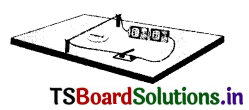
Activity 2
Question 2.
Show that the magnetic field around a bar magnet is three dimentional and its strength and direction varies from place to place.
Answer:
- Take a sheet of white paper and place it on the horizontal table.
- Place a bar magnet in the middle of the sheet.
- Place a magnetic compass near the magnet. It settles to a certain direction:
- Use a pencil and put dots on the sheet on either side of the needle. Remove the compass. Draw a small line segment connecting the two dots Draw an arrow on it from South Pole of the, needle to North Pole of the needle.
- Repeat the same by placing the compass needles at various positions on the paper. The compass needle settles in different directions at different positions.
- This shows that the direction of magnetic field due to a bar magnet varies from place to place.
- Now take the compass needle to places far away from magnet, on the sheet and observe the orientation of the compass needle in each case.
- The compass needle shows almost the same direction along north and south at places far from the magnet.
- This shows that the strength of the field varies with distance from the bar magnet.
- Now hold the compass a little above the table and at the top of the bar magnet.
- We observe the deflection in compass needle. Hence we can say that the magnetic field is three dimensional i.e., a magnetic field surrounds its source.
- From the above activities we can generalize that a magnetic field exists in the region surrounding a bar magnet and is characterized by strength and direction.
Activity 3
Question 3.
Explain the process of tracing magnetic field lines.
Answer:
- Place a white sheet of paper on a horizontal table.
- Place a compass in the middle of it. Put two dots on either side of the compass needle. Take it out.
Draw a line connecting the dots which shows the North and South of the earth. - Now place a bar magnet on the line drawn in such a way that its north pole points towards the Magnetic field lines geographic north.
- Now place the compass at the north pole of the bar magnet. Put a dot at the north pole of the compass needle.
- Now remove the compass and place it at the dot. It will point in other direction. Again put a dot at the north pole of the compass needle.
- Repeat the process till you reach the south pole of the bar magnet.
- Connect the dots from ‘N’ of the bar magnet to S’ of the bar magnet, with a’ free hand ctirve. You will get a curved line.
- Now select another point from the north pole of the bar magnet. Repeat the process for many points taken near the north pole.
- You will get different curves as shown in the figure.
- These lines are called magnetic field lines. They are Imaginary lines.
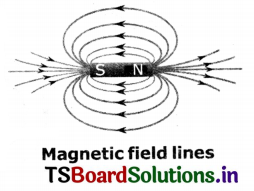
Activity 4
Question 4.
Describe an activity to find magnetic field due to straight wire carrying current. What Is its direction?
Answer:
1. Take a wooden plank and make a hole as shown in figure, Place this plank on the table.
2. Now place a retort stand on the plank as shown In figure.
3. Pass a 24 gauge copper wire through hole of the plank and rubber knob of the retort stand in such a way that the wire be arranged In a vertical position and not touch the stand.
4. Connect the two ends of the wire to a battery via switch.
5. Place 6 to lo compass needles in a circular path around the hole so that its centre coincides with the hole.
6. Use a 9V battery in the c!rcuet. Swtch on current and it flows through the wire.
7. We notice that they are directed as tangents to the circle.
8. The magnetic field around the wire is circular ¡n shape. This can be verified by sprinkling iron filings around the wire when current flows in the wire.
9. The direction of magnetic field around the wire will be as shown in the following figure.
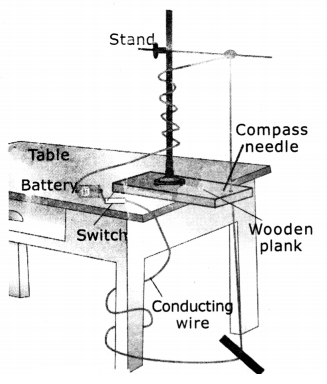
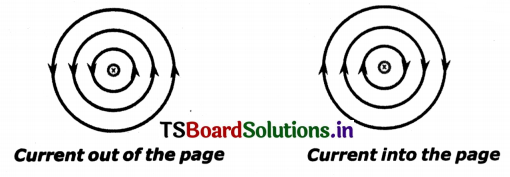
10. The direction of the magnetic field around the current-carrying wire can be determined by right-hand thumb rule ie., grab the current-carrying wire with your right hand in such a way that thumb is in the direction of current, then the curled fingers show the direction of magnetic field as shown in the figure.
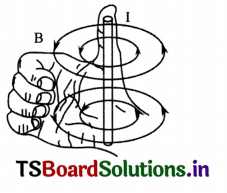
![]()
Activity 5
Question 5.
Trace the magnetic field due to circular coil.
Answer:
1. Take a thin wooden plank covered with white paper and make two holes on its surface as shown in the figure.
2. Pass insulated copper wire (24 guage) through the holes and wind the wire 4 to 5 times through holes
such that it looks like a coil.
3. The ends of the wire are connected to terminals of the battery through a switch. Now switch on the
circuit.
4. Place a compass needle on the plank at the centre of the coil. Put dots on either side of the compass needle.
5. Again place compass at one of the dots put other dots further.
6. Do the same till you reach the edge of the plank.
7. Now repeat this for the other side of the coil from the centre. Then draw a line joining the dots. We will get a field line of the circular coil.
8. Do the same for the other points taken In the between the holes. Draw corresponding lines. We will get field lines of the circular coil.
9. The direction of the field due to coil is s determined by using right-hand rule, which states that, when you curl your right-hand fingers in the direction of current, thumb waves the direction of magnetic field.
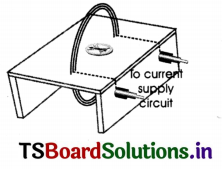
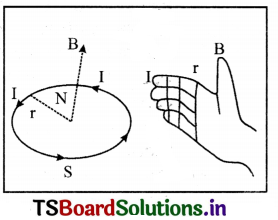
Activity 6
Question 6.
Find the magnetic field due to a solenoid.
(or)
Write the experimental procedure and observations of the experiment that is to be performed to observe the magnetic field formed due to solenoid.
Answer:
- Take a wooden plank covered with a white paper.
- Make equidistant holes on its surface as shown in the figure.
- Pass copper wire through the holes. This forms a coil.
- Join the ends of the coil to a battery through a switch.
- Switch on the circuit. Current passes through the coil.
- Now sprinkle Iron filings on the surface of the plank around the coil. Give-a small jerk to it, An orderly pattern Of iron filings is seen on the paper.
- The long coil is called solenoid. The field of solenoid is shown in the figure.
- This activity proves that current-carrying solenoid forms magnetic field.
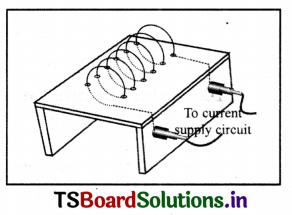
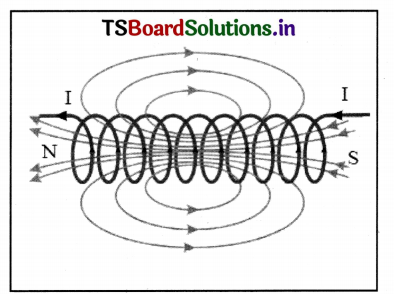
Activity 7
Question 7.
Explain magnetic force on moving charge and current carrying wire.
Answer:
(a) TV Screen Activity:
- Take a bar magnet and bring it near the TV screen.
- Then the picture on the screen is distorted.
- Here the distortion is due to the motion of the electrons reacting the screen are affected by the magnetic field.
- Now move the bar magnet away from the screen.
- Then the picture on the screen stabilizes.
- This must be due to the fact that the magnetic field exerts a torce on moving charges. This force Is called magnetic force.
- The magnitude of the force is F = Bqv where B Is magnetic induction, q’ is the charge and y Is the velocity of the charged partide.
(b) Procedure:
- Take a bar magnet near to the TV screen. We observe that electrons are affected by the field produced by the bar magnet. Then the picture Is disturbed.
- Move the bar magnet away from screen. Then you will get a clear picture.
- The force on the moving charge is given by F = Baqv.
- Right hand rule is used when velocity and field are perpendicular to each other
Fore-finger —- Direction of current (V).
Middle finger —- Direcrtion of field
Thumb —- direction of force
This rule is applicable to positive charge.
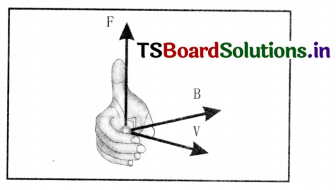
Activity 8
Question 8.
Explain the result of magnetic force applied on a current-carrying wire by an experiment.
(or)
Why the current carrying straight wire which is kept In a uniform magnetic field, perpendicularly to the direction of the field bends aside P Explain this process with a diagram showing the direction of forces acting on the wire?
Answer:
1. Take a wooden plank. Fix two long wooden sticks on It. These wooden sticks are split at their top ends.
2. A copper wire is passed through these splits and the ends of the wire are connected to a battery
of 3V, through a switch.
3. Close the switch to make the circuit. Current passes through the wire.
4. Now bring a horseshoe magnet near the copper wire as shown in the figure. Observe the deflection of the wire.
5. change polarities of the horseshoe magnet. Again observe the deflection. Repeat this by changing the direction of current in the circuit.
6. When current passes through wire, it produces a magnetic field and this field overlaps with the field by horseshoe magnet and gives a non-uniform field.
7. The field in between north arid south poles of horseshoe magnet is shown in the figure.
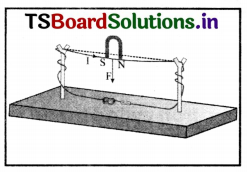
8. Let us make a wire passing perpendicular to the paper. Let the current pass through It. It produces magnetic field as shown in the figure.

9. The resultant field will be as shown below.
10. We can see that the direction of the field lines due to wire in upper part (of circular lines) coincides
with the direction of field lines of horseshoe magnet.
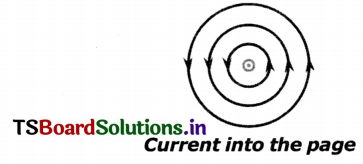
11. The direction of field lines by wire in lower part (or circular lines) Is opposite to the direction of the
field lines of horseshoe magnet. The net field in upper part is strong and in lower part it is weak. Hence a non-uniform field is created around the wire.
12. Therefore the wire tries to move to the weaker field region.
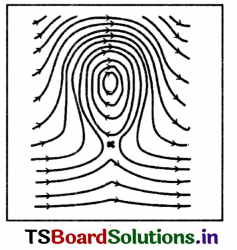
Activity 9
Question 9.
Take wooden base. Fix a soft iron cylinder on the wooden base vertically. Wind copper wire around the soft Iron as shown in the figure. Now take a metal ring which is slightly greater in radius than the radius of the soft iron cylinder and insert it through the cylinder on the wooden base. Now explain the behaviour of metal ring when the ends of copper wire are connected to (i) AC source and (ii) DC source.
Answer:
When the ends of copper wire are connected to AC source:
- Connect the two ends of copper wire to AC source and switch on the current.
- The metal ring Levitates due to net force acting on it is zero according to Newton’s second law.
Reason:
- AC changes both its direction and magnitude in regular intervals.
- Due to the magnetic field produced by current in the coil, one end of the coil behaves like North pole and the other end behaves like south pole for certain time interval.
- For the next interval, the coil changes its polarties.
- Assume that the current flows in clockwise direction in the solenoid as viewed from the top. Then the upper end becomes a south pole.
- An upward force Is applied on the ring only when the upper side of the ring becomes north pole.
- It Is only possible when there exists anti clock wise current viewed from the top in the ring.
- After certain intervals, solenoid changes its polarities, so that the ring should also change its polarities in the same intervals.
- This is the reason why the metal ring is levitated.
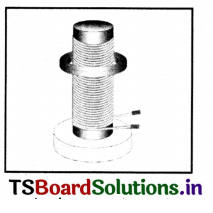
![]()
When the ends of copper wire are connected to a DC source:
- Now connect the ends of copper wire to a DC source.
- When the current is allowed to flow through the solenoid, It behaves like bar magnet. So the flux is linked to the metal ring when the switch is on.
- At that instant there is a change in flux linked with the ring. Hence the ring rises up.
- Thereafter, there Is no change In flux linked with coil, hence it falls down.
- If the switch is off, the metal ring again lifts up and falls down. In this case also there is change
in flux linked with ring when the switch is off.
